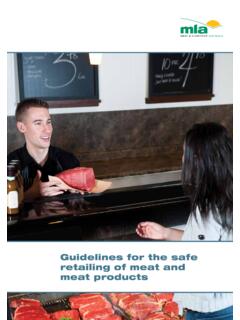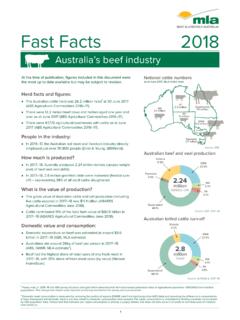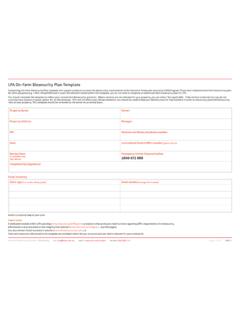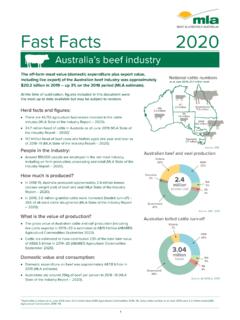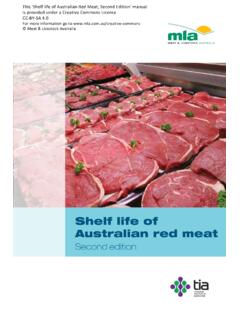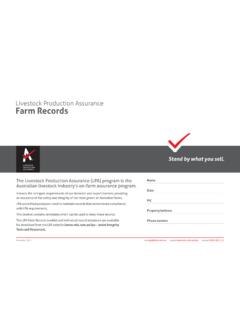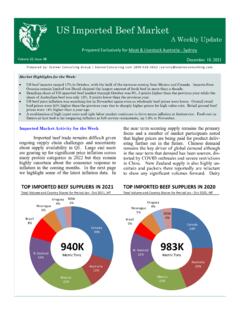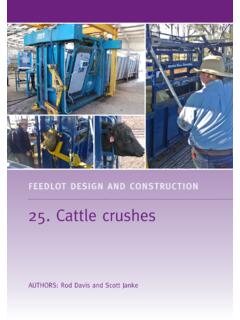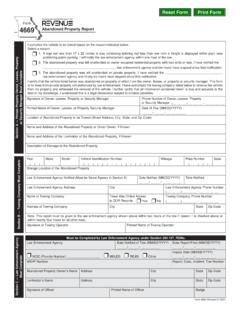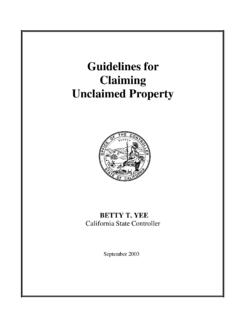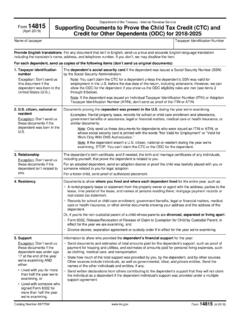Transcription of Commodity Vendor Declaration - Meat & Livestock Australia
1 Commodity Vendor Declaration Commodity DETAILS Commodity_____ Delivery Period_____ Variety_____ Quantity_____ Variety_____ Quantity_____ TOTAL QUANTITY:_____ 1. Commodity source (tick one) Single Source, Single Storage (eg off the header) Single Source, Comingled Storage (eg farm silo) Multi- Vendor Storage (eg grain depot, cotton gin seed storage) Factory Developed Product (eg ethanol plant, gluten plant) this Commodity contain restricted animal materials (eg meat and bone meal)? No Yes respect to Genetically Modified Organisms, this Commodity : (tick one) Is non GMO as defined by 99% non GMO Contains greater than 5% GMO or content unknown. Is non GMO as defined by 95% non GMO I, _____of_____declare that: a)I am the duly authorised representative of the Vendor supplying the Commodity ;b)All the information in this document is true and correct;c)I have read, understood and answered all questions in accordance with the explanatory notes.
2 D)I understand that regulatory authorities may take legal action, and purchasers may seek damages if the information provided is false or misleading Signature_____Date_____ Vendor DETAILS Name: _____ Address: _____ _____ Town: _____ Tel: _____ Fax: _____ Email: _____ National Grower Registration (NGR) No: _____ Property Identification Code (PIC):_____ Vendors contract/ reference No:BUYER DETAILS Name: _____ Address: _____ _____ Town: _____ Tel: _____ Fax: _____ Email: _____ National Grower Registration (NGR) No: _____ Property Identification Code (PIC):_____ Buyers contract No:Part A Product Integrity Part C - Declaration this Commodity within a withholding period (WHP), Export Slaughter Interval (ESI) or Export Animal Feed Interval (EAFI) followingtreatment with any plant chemical including a pickling or seed treatment, fumigant, pesticide or insecticide? No Yes, enter details in the table below Chemical applied Rate (Tonne/ Ha) Application date WHP/ ESI/ EAFI the Commodity been grown and/or stored under an independently audited QA program which includes chemical residuemanagement?
3 No Yes, provide details QA program_____ Accreditation/ Certification Number_____ If this Commodity has been grown or stored under such a QA program, please now read and sign Part C. If not, please now complete the remainder of Part B. 6. Is the Vendor of this Commodity currently aware of its full chemical treatment history or holds a CVD containing this history?No Yes 7. List all known adjacent crops grown within 100 metres of this Commodity (only applicable for single source commodities) 8. If the Commodity is a by-product, has a risk assessment been completed? (tick one) No Yes, attach copy of risk assessment N/A (see explanatory notes) 9. Has the Commodity been analysed for chemical residues or toxins by a lab accredited by NATA for the specific test required? No Yes, attach details of test results Part B Chemical Use May 2014 For information about the on-farm requirements of LPA accreditation visit: EXPLANATORY NOTES Commodity Vendor Declaration Who should sign this form?
4 You should only sign this form if you are the person representing the organisation supplying this Commodity and were responsible for the production and/or storage of this Commodity prior to dispatch to the buyer. Ensure that you answer all questions accurately and that you understand all elements of the Declaration and these explanatory notes. DETAILS Vendor details The producer s trading name or the name of the Commodity trader must be identified. If the seller ( Vendor ) of the Commodity is different to the producer or storage facility, then the Vendor s name and address should be filled out. Enter the Property Identification Code (PIC) and/or National Grower Register (NGR) number if they have been allocated. The Vendor s contract no. (if applicable) is the Vendor s individual contract number for the fodder being sold.
5 Buyer details The buyers name and address must be identified. The Buyer s contract no. (if applicable) is the individual contract number that the buyer has allocated for the Commodity being purchased. Commodity Details List the type of Commodity ( lucerne hay, barley, citrus pulp), the number of tonnes or bales and bale size covered by the Declaration , and the start and finish dates for delivery. PART A QUESTION 1 Answers to Question 1 are used to estimate the potential for mixing of the Commodity . If you are a Commodity trader you should provide copies of the individual Vendor Declarations completed by each supplier. Vendors should be aware that contamination could occur during loading and transport. Care should be taken that trucks and bins are clean prior to loading.
6 Transporters should be encouraged to use consignment notes for all loads. QUESTION 2 Restricted Animal Material (RAM) is defined as any material taken from a vertebrate animal other than tallow, gelatin, milk products or oils. RAM includes rendered products such as blood meal, meat meal, meat and bone meal, fish meal, poultry meal, feather meal, and compounded feeds made from these products. Commodities containing RAM must not be fed to ruminants. QUESTION 3 Only make a Declaration on the percentage of non GMO content if you are sure of its content. If you are unsure, declare content unknown . PART B QUESTION 4 List the full product name ( XYZ Diuron 900QG) for chemicals applied to the Commodity , whilst in your control, as well as the grams per litre or hectare of product used or the rate per hectare or tonne, application date and the relevant WHP/ESI/EAFI as shown on the chemical label or APVMA permit.
7 Include organic fertilisers (eg. Chicken manure). If there is insufficient space, attach an additional sheet in the same format (columns). NOTE: The withholding period (WHP) is the period stated on the product label or an APVMA permit that must elapse between the last application of a chemical and harvesting for human consumption or for stockfeed. NOTE: The export slaughter interval (ESI) is the minimum period that must elapse between the removal of Livestock to clean pasture or feed, and their slaughter, where the Livestock have been consuming the treated pasture or feed prior to the expiry of any export animal feed interval. NOTE: The Export Animal Feed Interval (EAFI) is the minimum period that must elapse between the application of a chemical to a crop or pasture and grazing or harvesting of the crop or pasture for stock feed for animals that may be slaughtered for export.
8 NOTE: When an EAFI has been established, and grazing or feeding has not occurred before its expiry, the ESI does not need to be observed. QUESTION 5 Answer Yes only if the property of origin or storage facility is Quality Assurance (QA) certified to ensure correct management of chemical residues and is audited by a third party organisation. NOTE: The Livestock Production Assurance (LPA) program is not an approved QA program. Examples of QA programs include Chem Check and Fodder Care. QUESTION 6 Answer Yes if you are able to provide residue test results, complete records of chemical treatments or Commodity Vendor declarations for all sources of supply of the Commodity . If you are unsure of the chemical treatment history of the Commodity you must tick No . QUESTION 7 List all crops known to have been grown within 100 metres of the crop from which this Commodity was harvested.
9 If a locust control authority has sprayed in the area, that use should also be noted. This includes crops grown on neighbouring properties. If the Commodity is mixed from multiple sources, leave the table blank. As an alternative you should provide copies of the individual Commodity Vendor Declarations completed by each grower that supplied feed for this consignment. QUESTION 8 This question is intended for by-products from agricultural and horticultural production (ie sugarcane tops or citrus pulp), from industrial processes (ie ethanol production) or from any Commodity that was not intended to feed Livestock , but may legally be fed to Livestock (ie does not contain RAM). If the Commodity was grown for the purpose of feeding to Livestock , tick N/A. SAFEMEAT has prepared risk assessment summaries for major by-product feedstuffs.
10 These risk assessment summaries are available from this link , from your peak industry body or from SAFEMEAT. QUESTION 9 Answer Yes if the Commodity covered by this Declaration has been tested for chemical residues, Annual Ryegrass Toxicity (ARGT), prussic acid (a sorghum crop that has been drought stressed and cut for fodder is potentially toxic to Livestock due to increased levels of prussic acid), aflatoxins (for peanut hay) or nitrites or any other substances. Results should be supplied as a copy of the laboratory s certificate of analysis. NOTE: NATA is the National Association of Testing Authorities. Any test performed should be accredited as part of the laboratory s NATA accreditation to ISO 17025. PART C Declaration Signing this Declaration has legal significance. Regulatory authorities may take legal action, and purchasers may seek damages if information is incorrect.
